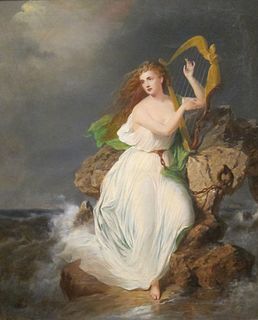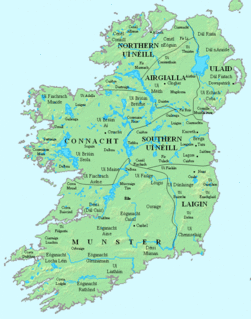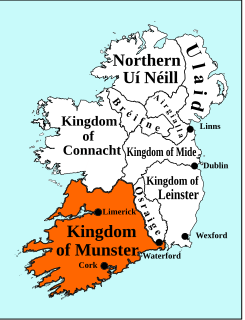Áine is an Irish goddess of summer, wealth and sovereignty. She is associated with midsummer and the sun, and is sometimes represented by a red mare. She is the daughter of Egobail, the sister of Aillen and/or Fennen, and is claimed as an ancestor by multiple Irish families. As the goddess of love and fertility, she had command over crops and animals and is also associated with agriculture.

In Irish mythology, Ériu, daughter of Delbáeth and Ernmas of the Tuatha Dé Danann, was the eponymous matron goddess of Ireland.

Medb —later forms Meadhbh and Méabh —is queen of Connacht in the Ulster Cycle of Irish mythology. Her husband in the core stories of the cycle is Ailill mac Máta, although she had several husbands before him who were also kings of Connacht. She rules from Cruachan. She is the enemy of Conchobar mac Nessa, king of Ulster, and is best known for starting the Táin Bó Cúailnge to steal Ulster's prize stud bull. Medb is strong-willed, ambitious, cunning and promiscuous, and is an archetypal warrior queen. She is believed to be a manifestation of the sovereignty goddess. Medb of Connacht is probably identical with Medb Lethderg, the sovereignty goddess of Tara, and may also be linked with the Morrígan. She may be the inspiration for the fairy Queen Mab found in William Shakespeare's Romeo and Juliet and other media.

The Connachta are a group of medieval Irish dynasties who claimed descent from the legendary High King Conn Cétchathach. The modern western province of Connacht takes its name from them, although the territories of the Connachta also included at various times parts of southern and western Ulster and northern Leinster. Their traditional capital was Cruachan.
Mongfind —meaning "fair hair" or "white hair"—is a figure from Irish legend. She is said to have been the wife, of apparent Munster origins, of the legendary High King Eochaid Mugmedón and mother of his eldest three sons, Brión, Ailill and Fiachrae, ancestors of the historical Connachta. She was Eochaid's first wife; his second wife, Cairenn, gave birth to Niall of the Nine Hostages. Several tales depict Mongfind as an adversary of Niall. Mongfind is also said to have been the sister of Crimthann mac Fidaig, King of Munster and the next High King of Ireland, whom she is said to have killed with poison in a bid to make her son king. She drank the poisoned drink to convince Crimthann, and died soon after at Samhain.

The Eóganachta or Eoghanachta were an Irish dynasty centred on Cashel which dominated southern Ireland from the 6/7th to the 10th centuries, and following that, in a restricted form, the Kingdom of Desmond, and its offshoot Carbery, to the late 16th century. By tradition the dynasty was founded by Conall Corc but named after his ancestor Éogan, the firstborn son of the semi-mythological 3rd-century king Ailill Aulom. This dynastic clan-name, for it was never in any sense a 'surname,' should more accurately be restricted to those branches of the royal house which descended from Conall Corc, who established Cashel as his royal seat in the late 5th century.

The Proto-Celtic language, also called Common Celtic, is the reconstructed ancestor language of all the known Celtic languages. Its lexis can be confidently reconstructed on the basis of the comparative method of historical linguistics. As Celtic is a branch of the Indo-European language family, Proto-Celtic is a descendant of the Proto-Indo-European language. According to one theory, Celtic may be closest to the Italic languages, which together form an Italo-Celtic branch. The earliest archaeological culture that may justifiably be considered as Proto-Celtic is the Late Bronze Age Urnfield culture of Central Europe from the last quarter of the second millennium BC. By the Iron Age Hallstatt culture of around 800 BC, these people had become fully Celtic.
Cathal mac Finguine was an Irish King of Munster or Cashel, and effectively High King of Ireland as well. He belonged to the Eóganacht Glendamnach sept of the dominant Eóganachta kin-group whose members dominated Munster from the 7th century to the 10th. His father, uncle, grandfather, and great-grandfather had also been kings of Cashel, so too were his son and grandson.
Ólchobar mac Cináeda was King of Munster from 847 until his death. He may be the "king of the Irish" who sent an embassy to Frankish Emperor Charles the Bald announcing a series of victories over Vikings in Ireland in 848.

The Kingdom of Munster was a kingdom of Gaelic Ireland which existed in the south-west of the island from at least the 1st century BC until 1118. According to traditional Irish history found in the Annals of the Four Masters, the kingdom originated as the territory of the Clanna Dedad, an Érainn tribe of Irish Gaels. Some of the early kings were prominent in the Red Branch Cycle such as Cú Roí and Conaire Mór. For a few centuries they were competitors for the High Kingship or Ireland, but ultimately lost out to the Connachta, descendants of Conn Cétchathach. The kingdom had different borders and internal divisions at different times during its history.
Ólchobar mac Duib-Indrecht was a supposed King of Munster from the Eóganacht Áine branch of the Eóganachta. His last paternal ancestor to hold the throne was Cúán mac Amalgado, five generations previous. His great grandfather Uisnech had been the brother of another King Eterscél mac Máele Umai. According to a genealogical tract Uisneach was heir apparent to the Munster throne until slain by his brother through envy and hatred and then Eterscél assumed the kingship of Munster.
Tnúthgal mac Donngaile was a supposed King of Munster from the Eóganacht Chaisil branch of the Eoganachta. He was a fifth generation descendant of Colgú mac Faílbe Flaind, a previous king.
Eóganacht Chaisil were a branch of the Eóganachta, the ruling dynasty of Munster during the 5th-10th centuries. They took their name from Cashel which was the capital of the early Catholic kingdom of Munster. They were descended from Óengus mac Nad Froích, the first Christian King of Munster, through his son Feidlimid mac Óengusa.
Eóganacht Áine or Eóganacht Áine Cliach was a princely house of the Eóganachta, dynasty of Munster during the 5th–12th centuries. They took their name from the Hill of Áine near the present day village of Knockainy, County Limerick. This region of Cliú is centred on the barony of Smallcounty in eastern Limerick. The nearby village of Emly was the ecclesiastical center of Munster at the time.
Eóganacht Glendamnach were a branch of the Eóganachta, the ruling dynasty of Munster during the 5th-10th centuries. They took their name from Glendamnach. They were descended from Óengus mac Nad Froích, the first Christian King of Munster through his son Eochaid mac Óengusa and grandson Crimthann Srem mac Echado. Kings of Cashel and Munster from the Eóganacht Glendamnach were:
Eóganacht Airthir Cliach were a branch of the Eóganachta, the ruling dynasty of Munster during the 5th-10th centuries. They took their name from Cliú, a territory in eastern Co.Limerick and parts of Tipperary. Airthir meant east and their territory was in the eastern section of this territory in Tipperary County around Tipperary town. They were descended from Óengus mac Nad Froích, the first Christian King of Munster through his son Eochaid mac Óengusa and grandson Crimthann Dearcon mac Echado. Crimthann's mother Dearcon was a member of the Arada Cliach, a minor group in Cliú.
Eóganacht Raithlind or Uí Echach Muman are a branch of the Eóganachta, the ruling dynasty of Munster during the 5th-10th centuries. They took their name from Raithlinn or Raithleann described around the area of Bandon, in the same area. Archaeologists believe that Garranes Ringfort in Templemartin parish, near Bandon, County Cork may have been Rath Raithleann, the royal seat of the Éoganacht Raithleann. They are descended from Mac Cass, the son of Conall Corc, the first King of Cashel, through Mac Cass' son Echu.
The Deirgtine or Clanna Dergthened were the proto-historical ancestors of the historical Eóganachta dynasties of Munster. Their origins are unclear but they may have been of fairly recent Gaulish derivation. Some evidence exists for their having been active in Roman Britain.

The House of Óengus is a proposed dynasty that may have ruled as Kings of the Picts, as well as overlords of the Kings of Dál Riata and possibly of all of northern Great Britain, for approximately a century from the 730s to the 830s AD. Their first ruler of Pictland was the great Óengus I of the Picts, who may be the figure carved into the St Andrews Sarcophagus pictured on the right.







